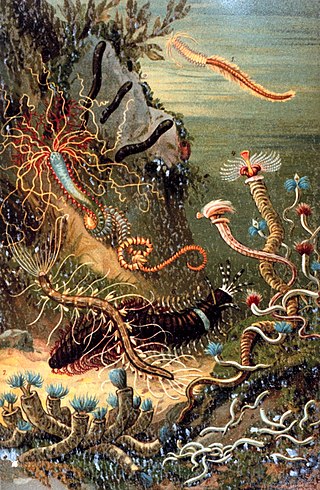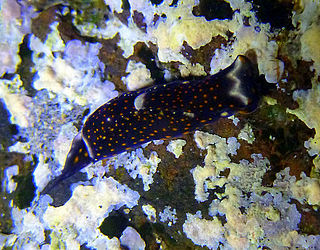
Polychaeta is a paraphyletic class of generally marine annelid worms, commonly called bristle worms or polychaetes. Each body segment has a pair of fleshy protrusions called parapodia that bear many bristles, called chaetae, which are made of chitin. More than 10,000 species are described in this class. Common representatives include the lugworm and the sandworm or clam worm Alitta.

Oligochaeta is a subclass of soft-bodied animals in the phylum Annelida, which is made up of many types of aquatic and terrestrial worms, including all of the various earthworms. Specifically, oligochaetes comprise the terrestrial megadrile earthworms, and freshwater or semiterrestrial microdrile forms, including the tubificids, pot worms and ice worms (Enchytraeidae), blackworms (Lumbriculidae) and several interstitial marine worms.

Epitoky is a process that occurs in many species of polychaete marine worms wherein a sexually immature worm is modified or transformed into a sexually mature worm. Epitokes are pelagic morphs capable of sexual reproduction. Unlike the immature form, which is typically benthic, epitokes are specialized for swimming as well as reproducing. The primary benefit to epitoky is increased chances of finding other members of the same species for reproduction.
Chaetopterus pugaporcinus, commonly known as the pigbutt worm or flying buttocks, is a species of worm first described by scientists at the Monterey Bay Aquarium Research Institute in 2007. The worm is round in shape, approximately 10 to 20 millimeters in length, and bears a strong resemblance to a disembodied pair of buttocks. Because of this, it was given a Latin species name that roughly translates to "resembling a pig's rear."

Chaetopterus or the parchment worm or parchment tube worm is a genus of marine polychaete worm that lives in a tube it constructs in sediments or attaches to a rocky or coral reef substrate. The common name arises from the parchment-like appearance of the tubes that house these worms. Parchment tube worms are filter feeders and spend their adult lives in their tubes, unless the tube is damaged or destroyed. They are planktonic in their juvenile forms, as is typical for polychaete annelids. Species include the recently discovered deep water Chaetopterus pugaporcinus and the well-studied Chaetopterus variopedatus.

Alitta succinea is a species of marine annelid in the family Nereididae. It has been recorded throughout the North West Atlantic, as well as in the Gulf of Maine and South Africa.

Odontosyllis enopla, commonly known as the Bermuda fireworm, is a polychaete worm that inhabits shallow areas of the western Atlantic Ocean. The organism is bioluminescent when it rises to the surface of the sea during its mating period. It is possible that this fireworm is the explanation of a candle-like light seen by Christopher Columbus during his first voyage on 11 October 1492 before he made landfall in his explorations.

Sabellastarte spectabilis is a species of benthic marine polychaete worm in the Sabellidae family. It is commonly known as the feather duster worm, feather duster or fan worm. It is native to tropical waters of the Indo-Pacific but has spread to other parts of the world. It is popular in aquariums because of its distinctive appearance and its ability to remove organic particles and improve water quality.

Chaetopterus variopedatus is a species of parchment worm, a marine polychaete in the family Chaetopteridae. It is found worldwide. However, recent discoveries from molecular phylogeny analysis show that Chaetopterus variopedatus sensu Hartman (1959) is not a single species.

Phyllodocida is an order of polychaete worms in the subclass Aciculata. These worms are mostly marine, though some are found in brackish water. Most are active benthic creatures, moving over the surface or burrowing in sediments, or living in cracks and crevices in bedrock. A few construct tubes in which they live and some are pelagic, swimming through the water column. There are estimated to be more than 4,600 accepted species in the order.

The annelids, also known as the segmented worms, comprise a large phylum called Annelida. The phylum contains over 22,000 extant species, including ragworms, earthworms, and leeches. The species exist in and have adapted to various ecologies – some in marine environments as distinct as tidal zones and hydrothermal vents, others in fresh water, and yet others in moist terrestrial environments.
Prosphaerosyllis battiri is a species belonging to the phylum Annelida, a group known as the segmented worms. The species name comes from an Aboriginal word, battiri, meaning 'rough'. Prosphaerosyllis battiri is a species characterized by having only partially fused palps, an unretracted prostomium on its peristomium or showing only slight retraction, the shape of its dorsal cirri and its arrangement of papillae, being numerous anteriorly while less numerous posteriorly. It resembles Prosphaerosyllis semiverrucosa, but its arrangement of dorsal papillae is reversed.
Odontosyllis phosphorea, commonly known as a fireworm, is a polychaete worm that inhabits the Pacific coast of North and Central America. The organism normally lives in a tube on the seabed, but it becomes bioluminescent when it rises to the surface of the sea during breeding season.
Nereis onychophora is a polychaete worm of the phylum Annelida. The type locality is in the Seram Sea, Indonesia.

Biuve fulvipunctata, the white-speckled headshield slug, is a species of sea slug or headshield slug, a marine opisthobranch gastropod mollusc in the family Aglajidae. This species is widespread in the Indian and Pacific Oceans but has invaded the Mediterranean Sea since 1961, despite apparently being absent from the Red Sea until recorded there in the 21st century. It is the only species in the monotypic genus Biuve.

Scolelepis squamata is a species of polychaete worm in the family Spionidae. It occurs on the lower shore of coasts on either side of the Atlantic Ocean.
Life That Glows is a 2016 British nature documentary programme made for BBC Television, first shown in the UK on BBC Two on 9 May 2016. The programme is presented and narrated by Sir David Attenborough.

Poecilochaetus serpens is a species of marine polychaete worm in the family Poecilochaetidae. It is a benthic worm that burrows into soft sediment.

Tomopteridae is a family of holopelagic polychaetes belonging to the order Phyllodocida. The genus Tomopteris consist of about 70 species, and the three other genera of one known species each. Length varies from just 1-2 cm to 30 cm. These are very active swimmers, and have some of the highest metabolic rate among annelids. To increase buoyancy they have a large body cavity (coelom) filled with body fluid of a density similar to seawater. With the coelom taking up much of the inner space, the muscular system has been reduced to a mesh just below the epidermis. The circulatory system has been lost, and the coelomic fluid has taken over the role of transporting oxygen, nutrients and gametes. Instead of a heart the inner surface of the worm is covered with cilia that moves the fluid around inside the body. The absence of septa between the segments makes the circulation more efficient. A series of extretory organs called metanephridia consists of ciliated funnels which opens to the coleomic cavity and connects with the exterior though a nephridiopore. Some species are bioluminescent, and produce a yellow light.
Diopatra claparedii is a species of tube-building polychaete worm of the family Onuphidae. It is found dispersed along intertidal and subtidal benthic environments of South Asian waters, especially along the coasts of Malaysia, Singapore, Thailand, and the Philippines. This species is exploited by humans for fishing bait, indication of marine pollution, and as gold and silver nanoparticle biosynthesis agents.













